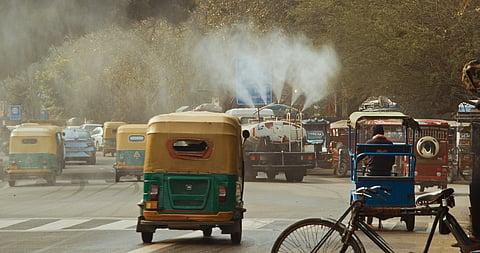

A total of 149 out of 281 surveyed cities were found to report their air quality in the poor category, a recent study based on assessing data in the two weeks after Diwali, has found.
The study titled Early Winter Trends Across Indian Cities was published today, on November 21, by Respirer Living Sciences, a climate-tech startup.
It highlighted that severe pollution levels concentrated in the Indo-Gangetic Plain, Northern, and Central regions, with Delhi emerging as the most polluted city.
The analysis also revealed a doubling of cities categorised as ‘Very Poor’, from 16 to 32 within the two weeks, underscoring the impact of early winter conditions like temperature inversions and reduced wind speeds that trap pollutants closer to the surface.
The study emphasised on the significant role of regional and seasonal factors in exacerbating air pollution.
“Delhi recorded an alarming PM2.5 average of 243.3 µg/m³, reflecting a 19.5% increase in only two weeks. Other northern cities, including those in Uttar Pradesh, Haryana, and Punjab, also reported high pollution levels, driven by industrial emissions, vehicular pollution, and stubble burning,” it found.
While it reported that while northern cities grappled with hazardous pollution, it also identified regions of cleaner air in southern and northeastern India.
“Cities such as Imphal, Manipur (14.2 µg/m³) and Ariyalur, Tamil Nadu (15.0 µg/m³) demonstrated significantly better air quality, attributed to favourable geography, effective local interventions, and lower industrial activity,” it added.
“This widespread poor air quality reflects the compounding effects of urbanisation, industrial emissions, and seasonal agricultural practices including stubble burning. It calls for the urgency to move towards targeted mitigation strategies, particularly in pollution hotspots across the Indo-Gangetic Plain,” Ronak Sutaria, founder of Respirer Living Sciences, was quoted in a press statement.
It called for a multi-pronged approach to combat air pollution, including stricter emission norms, promoting alternatives to stubble burning, expanding air quality monitoring infrastructure, and fostering cross-state collaborations to tackle cross-border pollution.
“Addressing air pollution requires a coordinated effort, combining stricter emissions norms, innovative alternatives to stubble burning, and better air quality monitoring. Clean air is achievable if we act decisively now,” Sutaria added.